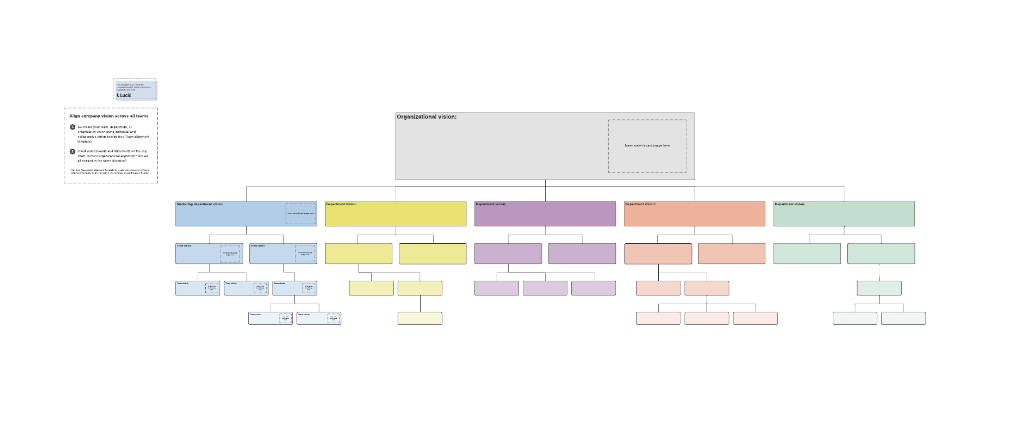
The warning signs and risks of poor organizational alignment
Reading time: about 9 min
How aligned is your organization? The truth is, you may be overestimating your organization’s alignment. In fact, many leaders are unaware of just how aligned—or misaligned—their organization is. Multiple studies reveal the discrepancies in perception:
- According to Gartner research, 77% of executives feel like they are a part of something important at their organization, but only 59% of employees feel the same.
- A recent study from Researchscape found that 47% of workers believe some projects fail to meet objectives due to alignment issues, and 46% express annoyance or frustration as a result of misalignment.
- And another study shows that only 28% of executives and middle managers responsible for executing strategy could list their company’s strategic priorities—with this percentage decreasing the further down the reporting line you look (MIT Sloan Management Review).
When you’re so attuned to the organization’s goals, strategy, and plans, it’s easy to assume that everyone else is too. But organizational misalignment could be the silent killer of your business’s efficiency and effectiveness.
Most strategic business initiatives, like developing new products or migrating to the cloud, require cross-functional alignment to be successful. When these teams aren’t working in alignment, projects progress slower, value delivery is disrupted, and profits suffer. Recognizing where alignment is breaking down—and taking intentional steps to increase alignment—could give your business the edge it needs to be competitive.
What is organizational alignment?
Organizational alignment refers to coordination, collaboration, and cohesion across all aspects of the business—from the high-level vision, mission, and strategy to the tactical plans, timelines, and action items. It’s an approach that leadership teams initiate with the intention of increasing employee engagement, innovation, and productivity. As a McKinsey article explains:
“Achieving real alignment, where strategy, goals, and meaningful purpose reinforce one another, gives an organization a major advantage because it has a clearer sense of what to do at any given time, and it can trust people to move in the right direction. The result is an organization that can focus less on deciding what to do—and more on simply doing.”
Why is achieving organizational alignment so difficult?
Unfortunately, achieving the level of organizational alignment needed to provide a competitive advantage is not an easy task. Businesses today are inherently complex, with multiple layers of processes, reporting, and tools to manage. And as businesses grow, organizational silos naturally form between teams.
Silos optimize work within a team, allowing team members to increase their technical expertise—but teams often struggle to share this knowledge outside of the silo, making cross-functional alignment difficult. A Forrester Consulting study found that 79% of decision-makers say cross-functional collaboration is a challenge because collaboration workflows are often conducted in silos. As a result, many teams have a limited view of the business and are often unaware of the work, goals, and findings across other teams.
The shift to hybrid work has further exacerbated the challenges posed by silos. Gallup research shows that “reduced cross-functional communication and collaboration” is a top challenge of hybrid work, cited by 23% of respondents. And many of the original benefits of silos, such as sharing information within specialized teams, are diminished with hybrid work.
But neither silos nor hybrid work is the problem in and of itself—the benefits each offers are valuable. The problems occur when organizations are unaware of the misalignment and fail to connect the silos in a hybrid workforce.
Warning signs of a misaligned organization
Misalignment in an organization often manifests in a few telltale ways. Here are a few red flags that may indicate your organization is in need of improved alignment.

Workers struggle to find the information they need
In misaligned organizations, workers either lack access to—or don’t know where to find—the information and data they need to move forward and make decisions. Siloed information is all too common today: A recent survey from Project.co revealed that 65% of people often experience difficulty finding the files they need. And 41% struggle to get an exact overview of a project’s status at any given time.
When different teams have a different understanding of a project or are referencing outdated information sources, this is a sign organizational silos are disrupting information flow in your organization.
Deadlines are routinely moved or missed
Meeting deadlines, especially for large projects, almost always requires the orchestration of cross-functional teams. In a recent survey, 40% of project managers say that 76% to 100% of their projects require collaboration outside of their immediate team.
These cross-functional teams must be aligned on objectives, dependencies, milestones, and accountabilities. If teams are not aligned on even one of these factors, the chance of someone unintentionally dropping the ball increases.
If teams across your organization are missing more deadlines than they’re meeting, it may indicate a lack of organizational alignment.
Teams waste too much time in unproductive meetings
Ever leave a meeting thinking you understand the project, goals, and deadlines—only to find out you walked away with a different understanding than another attendee? This scenario is all too familiar to many workers today, particularly those working with hybrid teams. And ironically, the go-to solution to remedy this misalignment is another meeting.
According to Project.co, two-thirds of people say they often waste time in meetings. Meetings are a necessary part of work, but if too much time is spent in repetitive or unproductive meetings, this could indicate that your workforce is struggling to reach and stay in alignment.
Risks of poor organizational alignment
The impact of misalignment in an organization is far-reaching. Some of the significant risks of poor organizational alignment, when unaddressed, include:
Faltering employee engagement
According to LSA research, 68% of companies with low organizational alignment (represented in the survey as alignment of strategy, culture, and talent) reported poor to very poor levels of employee engagement.
When employees feel disconnected from the larger organizational strategy and mission, they often struggle to find meaning in their work. And when their momentum is repeatedly halted by miscommunications, convoluted approval processes, and slow handoffs, it’s no wonder their motivation would take a hit as well.
Reduced business agility and lower customer satisfaction
To stay competitive, organizations need to adapt to the continually evolving market and customer needs. In a recent survey, 33% of enterprise decision-makers cite a “lack of coordination across teams or organizations within our company” as a top barrier to responding to change in the business environment.
And if organizations struggle to respond to change, they’ll have difficulty meeting (or exceeding) customer needs. In fact, 30% of low-alignment organizations indicated unsatisfied customers. Inversely, 96% of high-alignment organizations indicated satisfied customers (LSA research).
Stalled growth and revenue
Perhaps the greatest risk of organizational misalignment is the negative impact on the bottom line. Given the impact alignment has on employee engagement and customer satisfaction, it’s no wonder that highly aligned organizations increase revenue 58% faster and are 72% more profitable than unaligned organizations (LSA research).
By leaving organizational misalignment untreated, you risk missing out on a massive revenue-earning opportunity.
Quick tips for organizational alignment
Once you recognize the signs of a misaligned organization, you can take steps to improve alignment. Here are a few tips to get started:
Understand your value streams
One of the most effective ways to connect organizational silos is to align teams in support of delivering customer value. Value stream mapping is a great way to do this, as Jeff Rosenbaugh, senior director of professional services at Lucid, explains:
“Silos make it exceptionally difficult to identify blockers in delivering customer value—and they put value at risk by increasing handoffs and the burden of communication on teams. Value stream mapping can help bridge these silos and align the organization in a way that supports agile efforts.”

Manage your value streams
Learn more about mapping and managing value streams.
Get the step-by-step guideFoster a culture of transparency and communication
To help employees at all levels within your organization connect to your mission and vision, be transparent about your strategy, and keep the organization updated on key goals and metrics.
It may feel repetitive, but studies show that repetition is key. A recent report from Officevibe reveals that 1 out of 4 employees are either indifferent or unsure about their company’s mission, with 33% reporting that they aren’t reminded of the mission often enough.
As Jessica Gusitolise, an evangelist at Lucid explains, “Sharing where the company has been, where it’s at currently, and where you plan to take it, will help teams execute in an impactful way that aligns to the vision.”

Centralize company resources
Help your workforce find the resources they need and stay aligned on the most up-to-date information by creating a single source of truth, ideally in a cloud-based repository. Centralizing resources is key to organizational alignment: 85% of respondents from highly aligned organizations say employees have access to the resources they need (LSA research).
Make high-level information like the organization’s goals and mission available as well as team-level information like brainstorms, past decisions, processes, plans, diagrams, and more. When employees are working off the same, most current information, they’ll be able to keep projects moving forward efficiently.
Invest in tools that connect cross-functional teams
The right technology stack is essential to increasing alignment, particularly for hybrid teams. You may already enable communication with tools like Slack and Zoom and help teams manage projects with tools like Asana or Jira. A visual collaboration platform like Lucid is another essential technology to increase alignment. Through visual collaboration, cross-functional teams can collaborate in real time or asynchronously, clarify complex concepts, and stay aligned from ideas to action.
Remember, the goal isn’t to invest in more tools—it's to invest in the right tools. Prioritize integrations and comprehensive functionality when evaluating new tools. After all, a consolidated solution could be your competitive edge: 82% of respondents in a Forrester Consulting report say that investing in a cohesive collaboration solution allows their organizations to stay competitive and makes them a leader in their industry.
Achieving organizational alignment requires intentional effort, but the rewards are worth it. By recognizing the risks and warning signs of misalignment, and taking steps to enable cross-functional alignment, you can give your organization the boost of efficiency and engagement it needs.

Choose the right visual collaboration solution for your team
Find out how to choose a visual collaboration solution that enables continuous organizational alignment.
Get the guideAbout Lucid
Lucid Software is a pioneer and leader in visual collaboration dedicated to helping teams build the future. With its products—Lucidchart, Lucidspark, and Lucidscale—teams are supported from ideation to execution and are empowered to align around a shared vision, clarify complexity, and collaborate visually, no matter where they are. Lucid is proud to serve top businesses around the world, including customers such as Google, GE, and NBC Universal, and 99% of the Fortune 500. Lucid partners with industry leaders, including Google, Atlassian, and Microsoft. Since its founding, Lucid has received numerous awards for its products, business, and workplace culture. For more information, visit lucid.co.
Related articles
Bring your bright ideas to life.
or continue with
By registering, you agree to our Terms of Service and you acknowledge that you have read and understand our Privacy Policy.